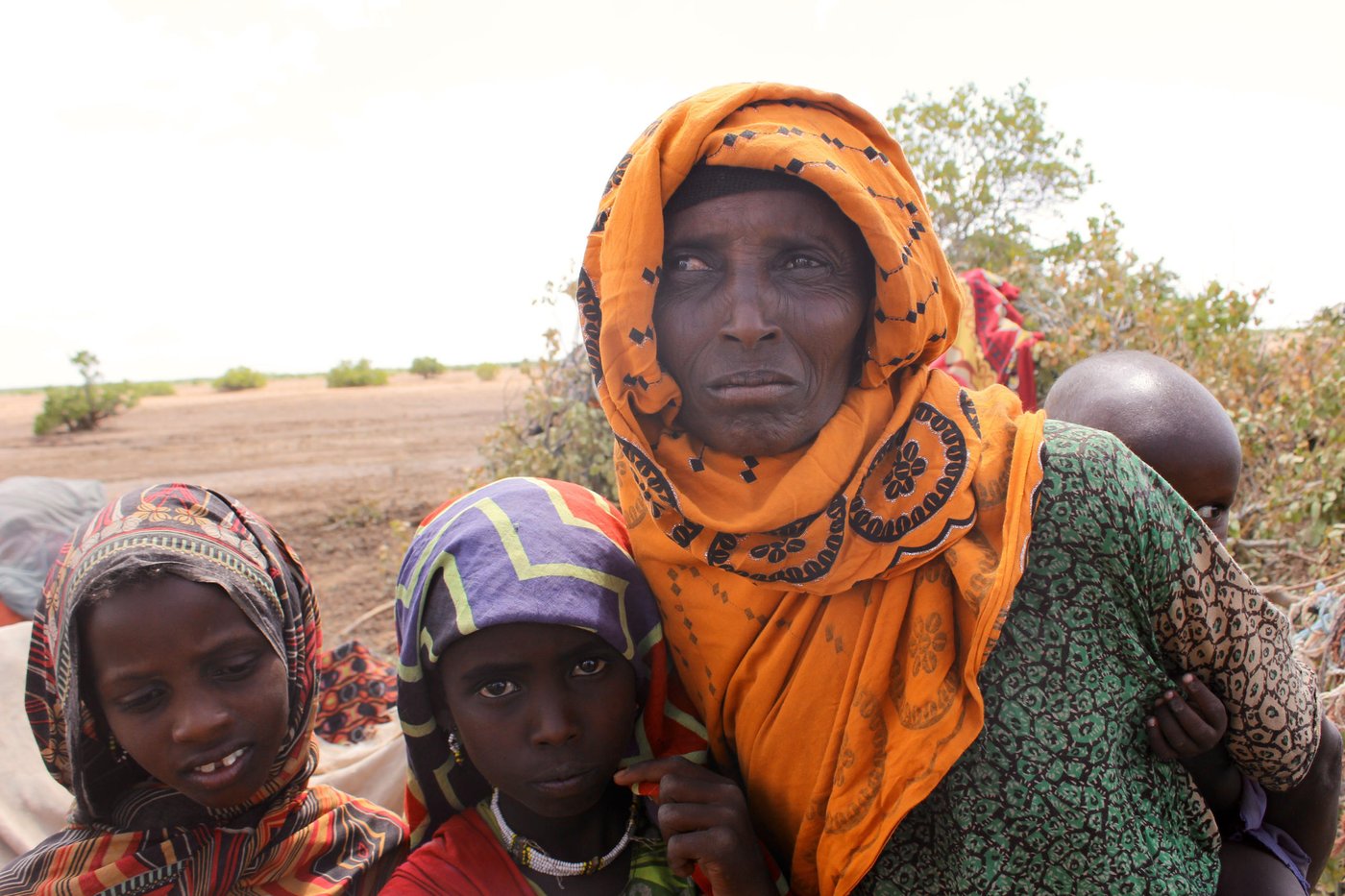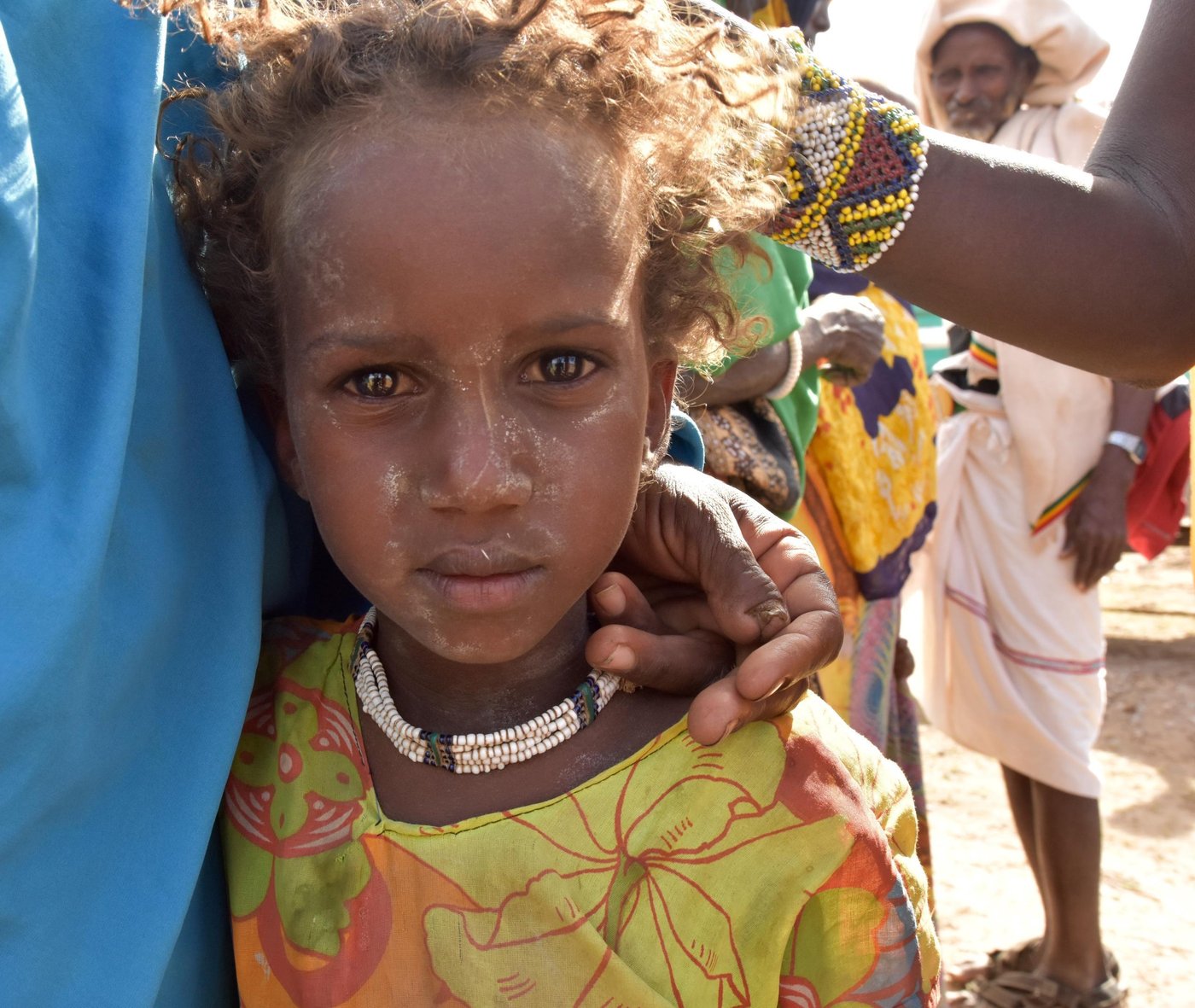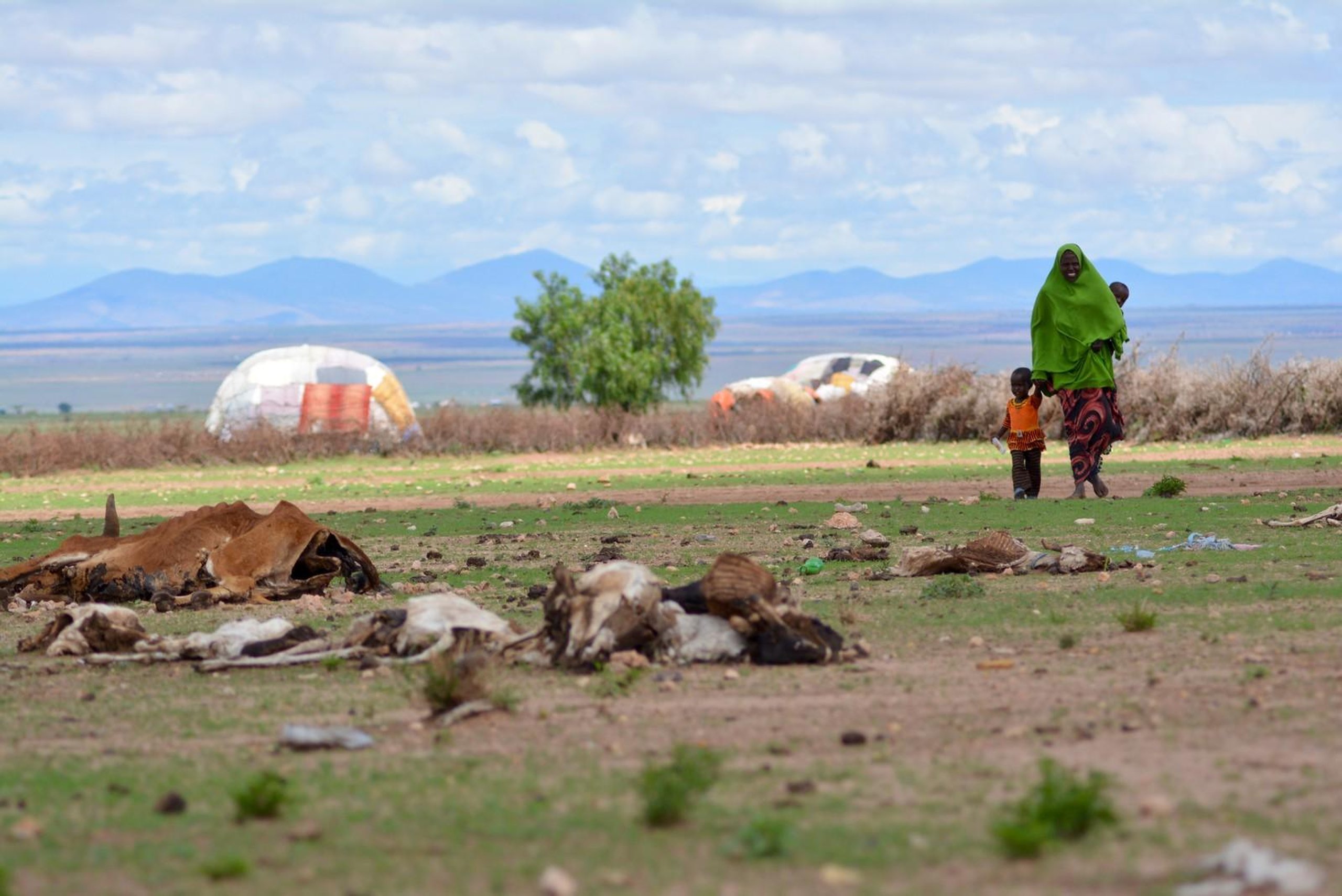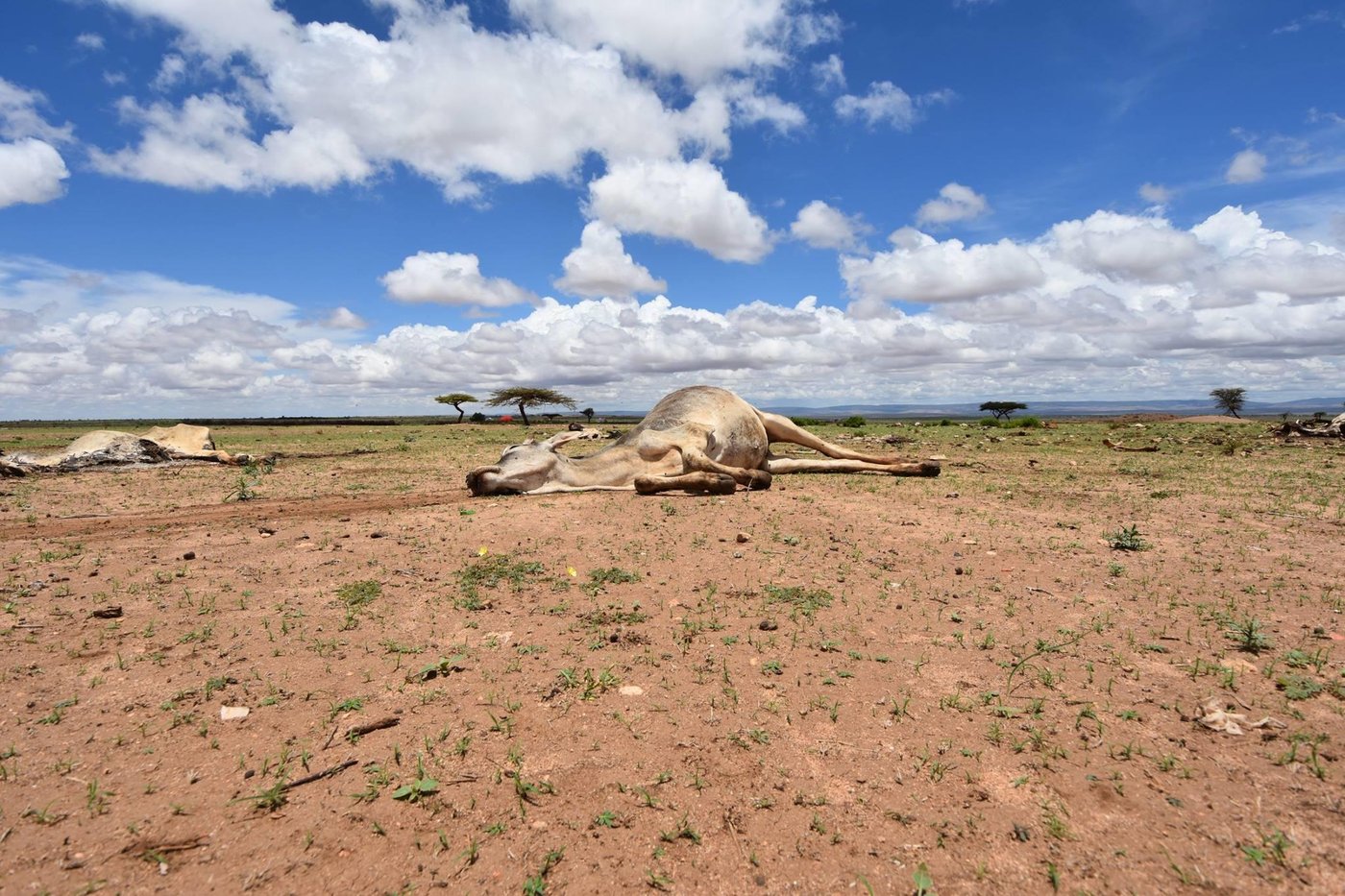“The world must understand that the drought affecting Ethiopia is a climate crisis that will haunt people for generations,” he warns.
You see them almost everywhere; dead animals lying on the arid ground as horrific reminders of the catastrophe this country is facing. The pastoralists affected by the drought all say the same: The drought took most of the livestock, then the recent heavy rain killed the rest. An estimated one million animals have died due to the recent droughts in Ethiopia.
Worst drought in lifetime
On the way to the drought-affected Hariso village in the Somali region we meet Madina Aden (48). Her small shelter is shared with at least ten other women, and a baby. In the shadow on the side of the tent lies four goats. The only ones she has left.
"I used to have 200 animals," she says. "I had camels, cattle, sheep, donkeys. But now, look, I only have these left," Madina adds, points towards the goats. Then Madina echo what so many other pastoralists affected by the drought are telling us; "I have never seen a drought like this. Never. And I am 48 years old now."

Dramatic change
In Ethiopia, the country worst affected by El Niño, 10.2 million people require food assistance and 6.8 million people need emergency health assistance and water. More than 8 of 10 Ethiopians live in rural areas where many families are dependent on their own agricultural production, living from harvest to harvest. When the harvest fail, it means trouble for many.
Drought comes often
In his office in Jigjia, in the Somali region of Ethiopia, Abdifateh Ahmed Ismael, the Regional Aid Coordinator and Humanitarian Advisor to the President, is worried. He knows too well that this drought is not the last.
"20 years ago the Somali region used to see 2-3 droughts once every ten years. But in the last 20 years that has changed dramatically. Because of climate change we see an increasingly amount of droughts and a new severity of drought. On top of that the droughts are coming back once every two to three years," he says.

Short recovery
The result is that people do not get enough time to recover from the last drought before the next one comes.
"The recovery period that people used to have was around 7 or 8 years. This has now been reduced to 1 to 2 years. For pastoralists that is not enough for a recovery period. And because of that pastoralists are driven out of their livelihood loosing their livestock," he says. Adding that deforestation and urbanisation adds to the looming crisis.
Lost dreams
Not far from Ismael's office in Jigjiga town we find the village of Barisle. Two girls are holding hands as they explain what has happened to all the dead livestock lying around the village.
"They died due to drought," Ayan (8) says, while her friend Asma(9) explains the word drought. "It is lack of livestock, lack of food and hunger," she says.
The two girls never attended school. When asked what children do in school they don't have an answer. As children of pastoralists they have spent all their life herding goats and sheep. They have experienced drought before, they say, and they have moved on.
20 years ago the Somali region used to see 2-3 droughts once every ten years. But in the last 20 years that has changed dramatically. Because of climate change we see an increasingly amount of droughts and a new severity of drought. On top of that the droughts are coming back once every two to three years.Abdifateh Ahmed Ismael, Regional Aid Coordinator and Humanitarian Advisor to the President, Jigjiga, Somali region, Ethiopia
No where to go
The families of Asma and Ayan have relied on coping mechanisms learned over many generations. When drought occurred people simply migrated to less affected areas. But the population has exploded in Ethiopia over the last 50 years, from 22.2 million to 95.5 million. In addition, there has been a boom in commercial agriculture, leaving grazing and watering areas used in the dry season inaccessible.
For many families, there is nowhere left to move when disaster hits. Asma and Ayan shows us the last cow in the village. The meagre cow has nothing left but her skin and bones.
"When I grow up I want to have hundred cows," Asma says. "Me too, hundred," says Ayan.
Need for change If Ismael heard the dreams of the two girls in Barisle he would probably smile of recognition. He himself used to be a pastoralist when growing up.
"I used to herd livestock during my childhood, but just because I had access to education I am sitting here now talking about these issues. If not, I would probably be a desperate pastoralist somewhere in the Somali region," he says. Adding that education is the key investment to ensure pastoralists' an entry point to other livelihoods.
Reducing vulnerability
The climate change will not allow these children to continue the same path as their parents, according to the experienced humanitarian. Too much land has been degraded.
"We need the international community to partner with us in reducing vulnerability to this drought, through building resilience, livelihood diversity, programs that will help people produce food without depending on the rain," Abdifateh says.Need for long term thinking In the village of Berisle the need for water is most urgent. "We collect rainwater, that's all," and old lady from the village explains.
Due to the latest droughts humanitarian agencies have been trucking water to the affected communities.
"The international community must understand that emergency response is okay as it saves lives, but we also need to have investments that reduces the need for emergency response in the future. You can support probably a million dollar in a small community that has been affected by the drought in a year. But you can spend 200 000 dollars to support the same community to drill a borehole and that addresses the problem not only during emergency but also addresses the problem of water shortage completely," Ismael says.

Prepared but need help
As the fastest growing economy in the world, Ethiopia is now far more resilient to shocks like El Niño, and better positioned to meet its challenges. But resources are still lacking. The UN has called Ethiopia's condition "a deteriorated humanitarian situation" and although the El Niño phenomenon itself is subsiding, its devastating human impact will increase in the coming weeks and months. The El Niño-related food insecurity is projected to peak between December 2016 and April 2017.
"We must remember that El Niño is not a one-off event but recurring global phenomena that we must address for future generations. We must highlight the need for long-term development," says Mohamed Hassan, Area Manager for Norwegian Refugee Council in Jigjiga and Dire Dawa.
Hassan used to live in Ethiopia and Somalia as a child. After more than 20 years he has now returned to work with humanitarian response in the drought affected communities.
Water is life
On a hilltop outside Halobiyo village in the Fafan zone of Ethiopia a group of children is eager to answer the question about the importance of water. They all know too well that water is life. The children here have been moving around with their parents, but as the livestock and the agricultural land disappeared they had to come to the village for help.
The local community is themselves dependent on food aid, but as the leader of the village says, they could not do anything but to share the little they had. But when it comes to water, this village had nothing.
"Normally they would collect water when it rains but when it doesn't rain for two years they are in trouble," Mohamed Hassan from NRC says.
Changes lives
To ease the burden on this community NRC has build a water reservoir in the village. The water scheme, locally named berkad, collects the rainwater, filters it before people can collect it from a water pump. The sound of the pouring water is a welcoming one in this area.
"Before I had to walk half day to collect water from far away," Kadrah says, while balancing a jerry can full of water on her back. "For me the access to water has changed my life," she says.
"If we could drill permanent water sources like boreholes, then people would live much better also after we leave," Mohamed Hassan says. "We must help people to become more self-reliant, and build individual and community capacity to respond to future shocks."
Ismael agrees. He is busy trying to convince donors and governments that people need to be given alternatives to traditional livelihood. People need to be dependent on something that is more resilient to drought. Because the drought will re-occur, again and again.


